OWC Gemini (1GbE)
Support Manual
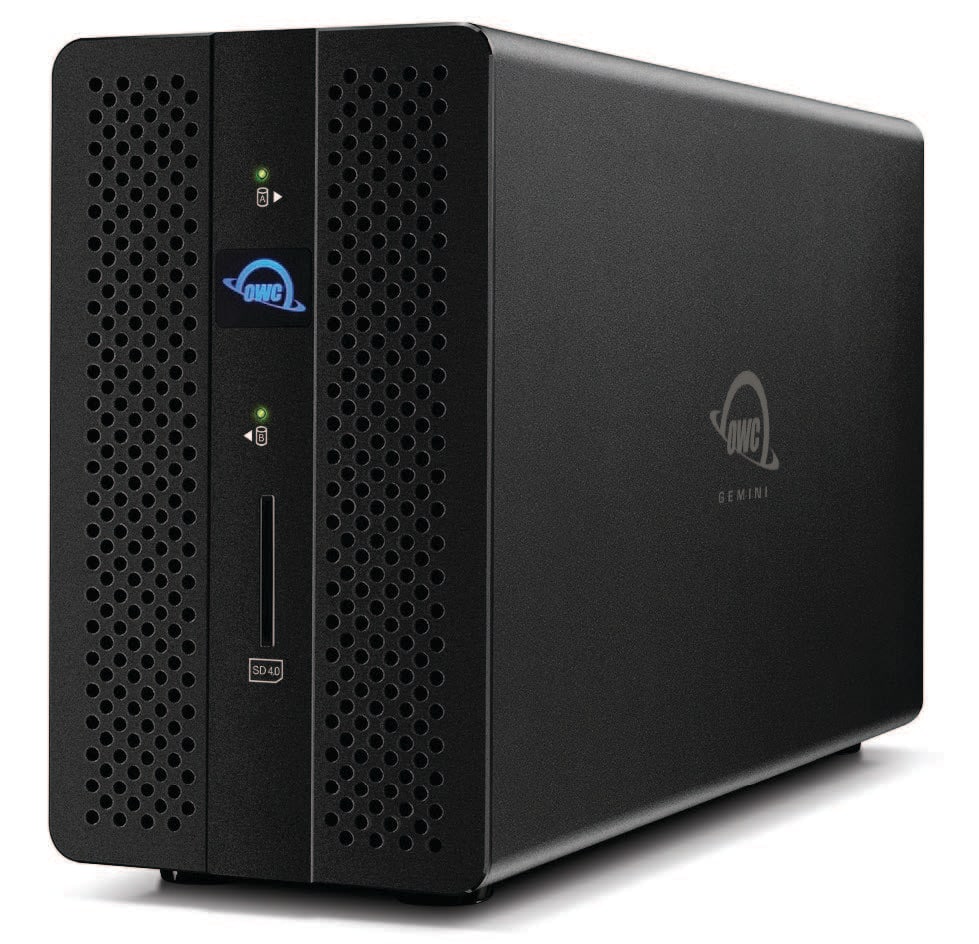
Introduction
1.1 System Requirements
Operating System
- Mac: macOS 10.14 or later
- PC: Windows 10 or later
Hardware
- Works with any Mac or PC with Thunderbolt 3
Supported Drives
- 3.5”/ 2.5” SATA HDDs/SSD
Supported Flash Media
- SD (up to 4.0 UHS-II) Cards
1.2 Package Contents
- (1) OWC Gemini (1GbE)
- (1) Thunderbolt cable
- (1) External power supply
- (1) Power cable
1.3 Front View
- Drive A Status LED – Blinks red for disk errors or missing disks. Blinks green during normal activity.
- Power LED – Solid white when connected to power. Solid blue when connected to both power and an active host.
- Drive B Status LED – Blinks red for disk errors or missing disks. Blinks green during normal activity.
- SD Media Slot – Supports SD 4.0 in UHS-II (Ultra High Speed II) with bus speed up to 156 MB/s (full duplex) or 312 MB/s (half duplex).
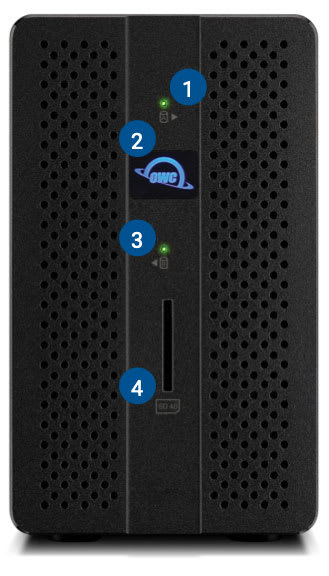
1.4 Rear View
- USB 3.1 Gen 1 hub ports – Supports USB devices with a Type-A connection
- Ethernet port – Left LED will show Green for 10M or 100M connection, Orange for 1G connection; Right LED will show Green for an established link and blink green during network activity.
Kensington Security slot – Attach a Kensington Security lock.
RAID selector dial – Select a desired RAID mode. See Section 2.4 “RAID Configuration” for more details regarding RAID management. NOTE: Only works with SATA drives
DC IN power port - Connect the power adapter to power the device.
- DisplayPort – Connect a DisplayPort display here.
Thunderbolt 3 ports – 40Gb/s, 27W Dynamic Power Delivery. 27W delivery to primary connected system or device. 15W delivery to secondary connected system or device.
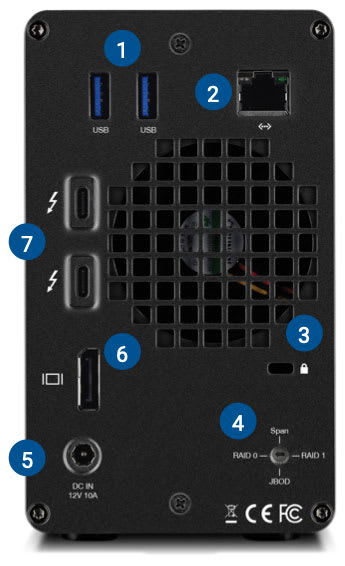
Getting Started
2.1 Device Setup
This section describes the process of setting up the OWC Gemini if purchased with pre-installed drives. The OWC Gemini is pre-configured as a Hardware RAID 0 volume.
- Plug the power cable into the OWC Gemini DC IN power port located on the back and into a power outlet. The Power LED will illuminate a solid white.
- Connect the included Thunderbolt cable into one of the two Thunderbolt 3 ports located on the back of the OWC Gemini and into a system. The Power LED will illuminate a solid blue.
NOTE: The OWC Gemini has (2) 40Gb/s Thunderbolt 3 ports with 27W Dynamic Power Delivery. 27W of power is delivered to the first connected system or device. 15W of power is delivered to the second connected system or device.
2.2 Assembly Steps
This section describes the process of installing drives into the OWC Gemini if purchased as a bare enclosure. For maximum performance install identical drives.
1. Begin by placing the device on a static free work surface.
2. Remove the two screws from the back of the enclosure. Store the screws for reassembly.
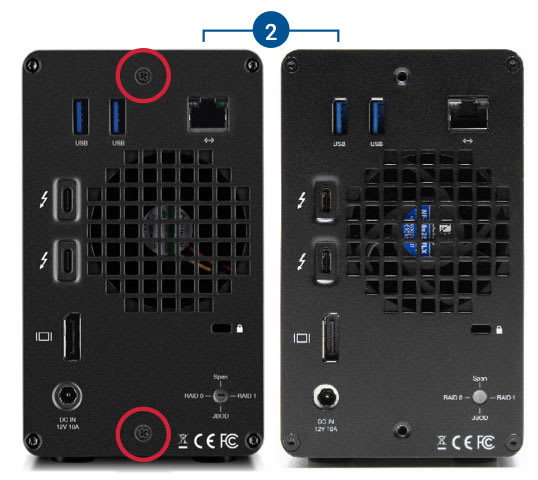
3. Pull on the front edge of the enclosure so the inner chassis slides out until fully removed.
4. Set the inner chassis flat on the work surface.

5. Set a 2.5-inch or 3.5-inch SATA drive into the drive housing. The label should be facing upwards. Carefully seat the drive. Minimal force is needed.
6. Affix the drive to the inner chassis. Holes for 3.5” drive screws are circled in red, and the hole for a 2.5” drive screw is circled in yellow.
NOTE: Only one drive screw is required for 2.5” drives, and (8) drive screws ((4) on each side) for 3.5” drives.
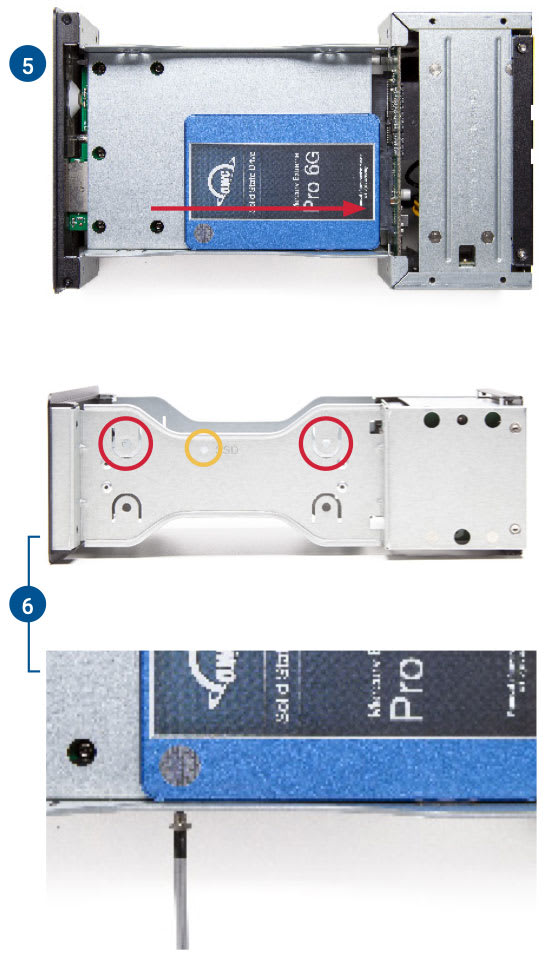
6. Ensure the ports on the back of the inner chassis and the port cut-outs on the back of the outer enclosure are oriented the same way, then slide the inner chassis into the outer enclosure so that the chassis’ front plate is flush with the cover’s front edge.
7. Secure the outer and inner chassis using the screws removed in Step 1.
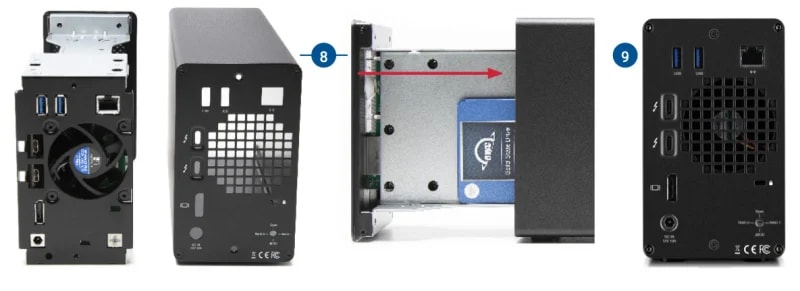
7. The installed drives are ready to be formatted. Please move onto Section 2.3 "Hardware RAID Configuration" for instructions on how to format and configure the OWC Gemini.
2.3 Hardware RAID Settings
This section describes the process of configuring or reconfiguring the OWC Gemini RAID mode.
NOTE: If there is any data on the drives being installed, changing the RAID mode will result in data loss.
1. Before connecting and powering on the OWC Gemini, select the desired RAID mode by rotating the RAID dial using a paper-clip or flat-head screwdriver. You should feel a slight click each time the arrow is aligned with a new RAID mode.
- The RAID mode is controlled by a dial near the bottom-right corner on the rear plate. The RAID mode will be set after powering on the OWC Gemini.
2. Plug the power cable into the OWC Gemini DC IN power port located on the back and into a power outlet. The Power LED will illuminate a solid white.
3. Connect the included Thunderbolt cable into one of the two Thunderbolt 3 ports located on the back of the OWC Gemini and into a system. The Power LED will illuminate a solid blue.
- NOTE: The OWC Gemini has (2) 40Gb/s Thunderbolt 3 ports with 27W Dynamic Power Delivery. 27W of power is delivered to the first connected system or device. 15W of power is delivered to the second connected system or device.
4. The drives are ready to be formatted. Formatting information is available by visiting go.owc.com/storage/formatting.
RAID 0 “Drive Striping” Mode
- The two drives show up as a single large disk with a size equal to the combined capacities of both drives. RAID 0 is used when speed is the primary objective; it does not provide data redundancy for protection. The reading and writing of data files are spread across both drives to gain speed by distributing the workload. This allows for the fastest data transfer rates, but if one drive fails the whole array becomes corrupted. The data will be lost.
- Identical SATA drives (model, capacity, firmware) are required.
RAID 1 “Drive Mirroring” Mode
- The two drives show up as a single disk with a size equal to the capacity of a single drive from the array. RAID 1 copies (or “mirrors”) the data from the first drive to the second drive. This is useful when reliability and redundancy are more important than capacity or maximum speed. When one drive fails, it can be replaced, and the data can be rebuilt automatically from the other functioning drive. See Section 2.5 “Replacing Drives” for more details on the drive replacement and rebuild process.
- Identical SATA drives (model, capacity, firmware) are required.
Span Mode
- Both drives show up as a single large disk, but one which functions differently than RAID 0. The total size will depend on the drives installed; unlike RAID 0 or RAID 1 you can use drives of different capacities. A span is an array (but not a RAID) in which the data is written sequentially across the drives. When one drive becomes full, subsequent data is written to the second drive. This combines the capacities of the drives, but it does not provide any performance or data redundancy benefits.
Independent Drive Mode
- Each drive will appear individually without being combined.
Device Management
3.1 Drive Failure
- If one of the SATA drives in RAID 1, 0, or Span fails (or is missing or not connected properly), the corresponding drive LED on the front of the device will light up a solid red.
- If the OWC Gemini was configured as a RAID 0, the data on the array is lost and the disk is no longer usable.
- When in Span, only the data stored on the failed drive is lost, although data recovery software will be required to retrieve the data from the other drive.
- If the drives were configured into Independent mode, then the data on the drive that did not fail will remain intact.
3.2 Replacing Drives
- If the Gemini is set up as a RAID 1, a drive that has failed can be replaced to rebuild the array. The data will remain accessible via the functioning drive until the array is rebuilt with a new drive.
- Drives being used as a RAID 0, Independent, or Span don’t have a rebuild option as the data is loss. If the enclosure was purchased with drives and it is still under warranty, contact OWC technical support for assistance (see Section 4.4 “Contacting Support”). If the unit is outside its warranty or was purchased without drives, follow the assembly instructions to access and replace the failed drive.
NOTE: A failed drive must be replaced with an identical drive (model, capacity, firmware)
NOTE: The OWC Gemini needs an active data signal to remain powered on. If it is disconnected from the computer, or if the computer goes to sleep or turns off, the device will power off. To minimize the rebuild time, it is recommended to keep the device connected to the computer (with the computer powered on), and disable any drive sleep settings on the computer for the duration of the rebuild. While rebuilding, the Drive LED indicator of the original drive has a slow pulsing green light, and the Drive LED indicator of the new drive will light up a solid red. The Drive LED indicator statuses will return to normal once the rebuild process is complete.
3.3 OWC Disk Performance
As of Windows 10 v. 1809 the default Disk Removal Policy is ‘Quick removal’ instead of ‘Better performance’.
NOTE: OWC storage solutions that are experiencing slow read/write speeds should consider checking and changing the Windows disk removal policy. Changing from "Quick removal" to "Better performance" can increase disk performance. OWC offers the application OWC Disk Performance to help change the Disk Removal Policy. Changing from "Quick removal" to "Better performance" can also be changed through OWC SoftRAID or manually through the operating system.
Please review the support article Storage Solutions: OWC Disk Performance for additional details.
3.4 Manually Unmounting Volumes
To ensure no data is lost during normal use, always eject or unmount the corresponding volume(s) from the operating system before powering off and disconnecting the device. Unmounting options are provided below.
macOS
- Drag the icon for the device you wish to unmount to the trash can; OR
- Right-click the device icon on the desktop, then click “Eject”; OR
- Highlight the device on your Desktop and press Command-E.
Windows
- Windows 10 build 1809 (October 2018) or later:
- Eject the drive by clicking the ‘Show hidden items’ menu in the Taskbar, then clicking ‘Safely Remove Hardware and Eject Media’, and last select the ‘Eject’ option for this volume.
- Windows 10 build 1803 and earlier:
- Go to the System Tray (located in the lower right corner of your screen). Click on the “Eject” icon (a small green arrow over a hardware image).
- A message will appear, detailing the devices that the “Eject” icon controls, i.e., “Safely remove...” Click on this prompt.
- You will then see a message that says, “Safe to Remove Hardware.” It is now safe to disconnect the device from the computer.
3.5 OWC Innergize Software
- A software application included with OWC Atlas media cards that currently provides three basic functionalities to the user: Health, Sanitize and Field Firmware Upgradability.
- The Health function allows the user to know how much life is left on their OWC Atlas media card
- Sanitize removes ghost data on OWC Atlas media cards which will allow the media cards to perform at their peak and out of factory condition performance in matter of seconds
- Field Firmware upgradability allows OWC to deliver live updates to our memory cards without the hassle of sending them in for an update.
Installing OWC Innergize
- Download OWC Innergize application based on the system:
- Open the downloaded Innergize.dmg file to begin and complete the installation process.
- For additional information regarding OWC Innergize please consult the support manual "OWC Innergize User Guide".
Required Firmware Update
OWC Innergize requires a firmware update to work properly with select OWC Memory Card Readers, Docks, and Storage Solutions.
- Ensure the OWC Gemini is powered and connected to a compatible system with the included data cable.
- Insert an OWC Atlas SDXC memory card into the SD Media Slot of the OWC Gemini. Align the memory card notches with the internal card reader connections. The gold contacts should be facing left when the memory card is inserted. This allows the system to recognize the card reader.
- In a Windows environment, download the OWC Innergize Firmware Update for the OWC Gemini.
NOTE: Mac users will require additional steps to complete the installation of the firmware. The firmware update is completed through the Windows operating system, therefore a Windows operating system emulator “Parallels” will need to be downloaded. - In a Windows environment, access the system Downloads folder and open the downloaded Compressed Folder. The compressed folder will open showing a firmware updater folder, and PDF/Word instructions for completing the firmware update process. Before accessing the firmware updater folder, open the instructions and proceed through the provided steps.
- For additional information regarding the OWC Innergize firmware update please consult the support article based on the system:
3.6 Usage Notes
- Identical SATA drives (model, capacity, firmware) are required for RAID 1 and RAID 0 configurations.
- Requires 1Gbs Ethernet compatible hardware components and cabling (Cat 5e cable minimum, Cat 6 or later strongly recommended).
- The cable type, i.e Cat5e, Cat 6a, is a silkscreen located physically on the cable. Inspecting the cable will help you identify the cable type.
- USB ports on the back of the OWC Gemini are backwards compatible with USB 3.0 and USB 2.0 devices.
- Thunderbolt/Thunderbolt 2 device compatibility requires a certified Thunderbolt 3 (USB-C) to Thunderbolt 2 (mDP) adapter and a Thunderbolt 2 cable.
- Compatibility and performance will be at Thunderbolt/Thunderbolt 2 speeds. (Sold separately at go.owc.com/apple/tb3tb2adapter).
- Experienced display support will vary among systems. Please consult the system manufacture specifications to determine the maximum supported resolution, refresh rate, color depth, and number of external displays over Thunderbolt.
- The OWC Gemini has (2) 40Gb/s Thunderbolt 3 ports with 27W Dynamic Power Delivery. 27W of power is delivered to first connected system or device. 15W of power is delivered to the second connected system or device.
- 1229MB/s write, and 1512MB/s read peak performance with 1 x 2.0TB Western Digital U.2 SSD in OWC Gemini PCIe x2 bay connected to a 13-inch MacBook Pro 2016 (MacBookPro13,2) with 8GB RAM and 2.9GHz processor running AJA System Test (4K-Full resolution, 16GB file size, 16 bit RGBA codec, single file test)
Support Resources
4.1 Troubleshooting
- Begin by verifying that the power cable is connected to the Gemini and to a power source. If the power cable is connected to a power strip, make sure that the power strip switch is in the ON position. Next, verify that each end of the data cable is properly plugged into the computer and the Gemini, respectively. If you are still having trouble, try connecting a different Thunderbolt 3 cable and see if the Gemini works properly; you can also connect the device to a different computer.
- If one of the drive LEDs (Drive 1 or Drive 2) lights up a solid red, then that drive has failed, is not fully connected, or is missing. If you purchased the Gemini as an empty enclosure, or the enclosure shipped with drives installed but is past the three-year warranty period, unmount the disk from the OS, power off, and replace the drive as outline d in Section 2.2 “Assembly Steps”. If the Gemini is configured as a RAID 1 and the rebuild LED is pulsing, please wait for the rebuild process to complete. If the rebuild LED is still blinking after more than 48 hours, or if you still need assistance for other reasons, please contact our Support team.
- If issues continue to occur, please know that OWC support is here to help. Contacting support information can be found in Section 4.4. Please have your serial number ready which is located on the bottom of the OWC Gemini and printed on the original packaging.
4.2 Online Resources
- Gemini Product Page: go.owc.com/gemini
- Gemini Installation Video: go.owc.com/gemini/install
- SoftRAID Quick Start Guide: go.owc.com/softraid/qsg
- SoftRAID Knowledgebase: go.owc.com/softraid/faq
- SoftRAID Mac to Windows Guide: go.owc.com/softraid/convert-ntfs
- Dock Ejector: go.owc.com/dockejector
- Dock Ejector Manual: go.owc.com/dockejector/manual
- OWC Innergize Support Guide: start.owc.com/innergize
- Innergize Overview Page: go.owc.com/innergize
- Drive Guide Manual: go.owc.com/driveguide/manual
- Drive Formatting: go.owc.com/storage/formatting
- Data Migration: go.owc.com/datamigration
- ClingOn Securing Device: go.owc.com/clingon
- Thunderbolt 3 to Thunderbolt 2 Adapter: go.owc.com/apple/tb3tb2adapter
4.3 About Data Backup
To ensure that your files are protected and to prevent data loss, we strongly suggest that you keep two copies of your data: one copy on your Gemini and a second copy on either your internal drive or another storage medium, such as an optical backup, or on another external storage unit. Any data loss or corruption while using the Gemini is the sole responsibility of the user, and under no circumstances may OWC, its parents, partners, affiliates, officers, employees, or agents be held liable for loss of the use of data including compensation of any kind or recovery of the data.
4.4 Contacting Support
4.5 About This Manual
The images and descriptions may vary slightly between this manual and the unit shipped. Functions and features may change depending on the firmware version. The latest product details and warranty information can be found on the product web page. OWC’s Limited Warranty is not transferable and
General Use Precautions
- To avoid damage, do not expose the device to temperatures outside the following ranges:
- Environmental (Operating)
- Temperature (ºF): 41º — 95º
- Temperature (ºC): 5º — 35º
- Environmental (Non-Operating)
- Temperature (ºF): -4º — 140º
- Temperature (ºC): -20º — 60º
- Environmental (Operating)
- Always unplug the device from the electrical outlet if there is a risk of lightning or if it will be unused for an extended period-of-time. Otherwise, there is an increased risk of electrical shock, short-circuiting, or fire.
- Protect your device from excessive exposure to dust during use or storage. Dust can build up inside the device, increasing the risk of electrical shock, short-circuiting, or fire.
Safety Precautions
- Use proper anti-static precautions when handling this device. Failure to do so can increase the risk of electrical shock or short-circuiting.
- Never expose your device to rain, or use it near water, or in damp wet conditions. Never place objects containing liquids on the device, as they may spill everywhere and into the openings. This will increase the risk of electrical shock, short-circuiting, fire, or personal injury.
- To avoid any risk of electrical shock, short-circuiting, fire, or dangerous emissions, never insert any metallic object into the device.
- Please cease use of the device and contact OWC Support if it appears to be malfunctioning.
Terms & Condition of Sale
Changes
The material in this document is for information purposes only and subject to change without notice. While reasonable efforts have been made in the preparation of this document to assure its accuracy, OWC, its parent, partners, affiliates, officers, employees, and agents assume no liability resulting from errors or omissions in this document, or from the use of the information contained herein. OWC reserves the right to make changes or revisions in the product design or the product manual without reservation and without obligation to notify any person of such revisions and changes.
FCC Statement
Warning! Modifications not authorized by the manufacturer may void the user’s authority to operate this device. NOTE: This equipment has been tested and found to comply with the limits for a Class B digital device, pursuant to Part 15 of the FCC Rules. These limits are designed to provide reasonable protection against harmful interference in a residential installation. This equipment generates, uses and can radiate radio frequency energy and, if not installed and used in accordance with the instructions, may cause harmful interference to radio communications. However, there is no guarantee that interference will not occur in a particular installation. If this equipment does cause harmful interference with radio or television reception, which can be determined by turning the equipment off and on, the user is encouraged to try to correct the interference by one or more of the following measures:
- Reorient or relocate the receiving antenna.
- Increase the separation between the equipment and receiver.
- Connect the equipment to an outlet on a circuit different from that to which the receiver is connected.
Warranty
The OWC Gemini has a 3 Year OWC Limited Warranty if it was bundled with drives. Gemini enclosures that do not ship with drives have a 1 Year OWC Limited Warranty. For up-to-date product and warranty information, please visit the product web page.
Changes
The material in this document is for information purposes only and subject to change without notice. While reasonable efforts have been made in the preparation of this document to assure its accuracy, OWC, its parent, partners, affiliates, officers, employees, and agents assume no liability resulting from errors or omissions in this document, or from the use of the information contained herein. OWC reserves the right to make changes or revisions in the product design or the product manual without reservation and without obligation to notify any person of such revisions and changes.
FCC Statement
Warning! Modifications not authorized by the manufacturer may void the user’s authority to operate this device.
NOTE: This equipment has been tested and found to comply with the limits for a Class B digital device, pursuant to Part 15 of the FCC Rules. These limits are designed to provide reasonable protection against harmful interference in a residential installation. This equipment generates, uses and can radiate radio frequency energy and, if not installed and used in accordance with the instructions, may cause harmful interference to radio communications. However, there is no guarantee that interference will not occur in a particular installation. If this equipment does cause harmful interference with radio or television reception, which can be determined by turning the equipment off and on, the user is encouraged to try to correct the interference by one or more of the following measures:
- Reorient or relocate the receiving antenna.
- Increase the separation between the equipment and receiver.
- Connect the equipment to an outlet on a circuit different from that to which the receiver is connected.
Copyrights and Trademarks
No part of this publication may be reproduced, stored in a retrieval system, or transmitted in any form or by any means, electronic, mechanical, photocopying, recording or otherwise, without the prior written consent of OWC.
© 2019 Other World Computing, Inc. All rights reserved. Gemini, OWC and the OWC logo are trademarks of New Concepts Development Corporation, registered in the U.S. and/or other countries. Mac and macOS are trademarks of Apple Inc., registered in the U.S. and other countries. Thunderbolt and the Thunderbolt logo are trademarks of Intel Corporation in the U.S. and/or other countries. Other marks may be the trademark or registered trademark property of their owners.
Free Support Chat
Our free award-winning support team is ready to answer all of your questions. Technical support is available Monday - Friday: 9AM - 6PM. Customer Support & Sales is available Monday - Friday: 9AM - 6PM. Support is unavailable on U.S. Federal holidays. Talk to a human today.

 1-800-275-4576
1-800-275-4576